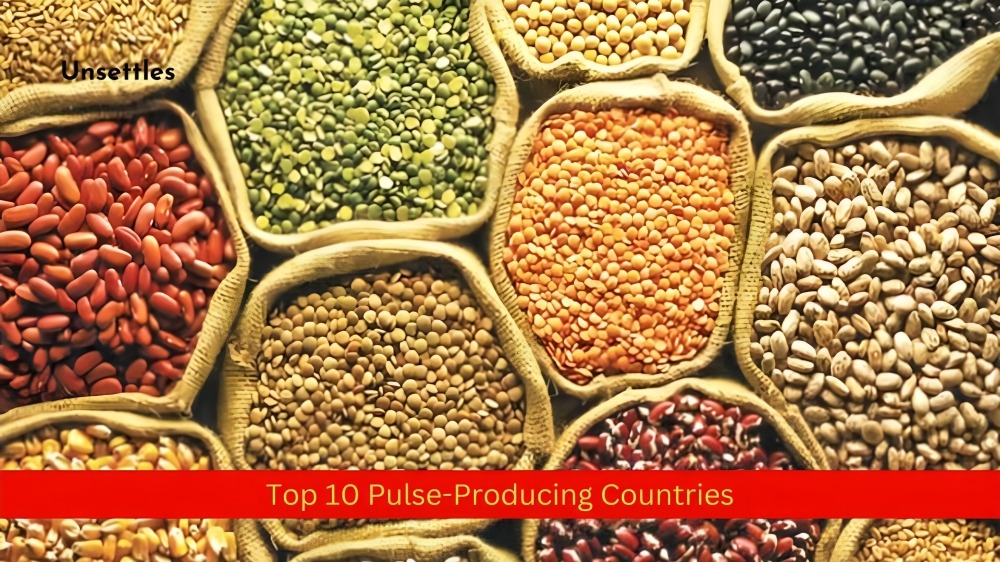Pulse-Producing Countries: Pulses—those little nutritional dynamos packed with protein, fiber, vitamins, and minerals—have long been a staple in kitchens worldwide. From cozy Indian households to the bustling markets of China and beyond, pulses play a central role in cuisines across the globe. But they’re not just a nutritional powerhouse; they’re also a sustainable crop that’s easy on the planet. Given the ever-growing demand for these plant-based goodies, it’s time to take a closer look at the countries leading the charge in pulse production for 2024. Let’s dive into the top 10 largest producers of pulses this year and see who’s dominating the pulse scene.
1. India – 2,176,908 Metric Tons
When it comes to pulses, India reigns supreme. In 2024, India solidified its position as the world’s top pulse producer with a whopping 2,176,908 metric tons. Pulses are not only a crucial part of Indian diets but also the backbone of the country’s agricultural output. In just two decades, India has more than doubled its pulse production, climbing from 13.37 million metric tons in 2002 to today’s impressive numbers. With crops like cumin, black pepper, and turmeric thriving in its diverse climates, India continues to set the gold standard for pulse production worldwide. Pulse-Producing Countries
2. Myanmar – 7.4-7.5 Million Metric Tons
Myanmar may be a smaller player on the global stage, but it’s making waves in the pulse industry. In 2021, the country exported over 2 million tonnes, and it hasn’t slowed down since. For 2024, Myanmar is expected to produce between 7.4 and 7.5 million metric tons of pulses, securing its spot as the second-largest pulse producer. Known for producing a variety of pulses, Myanmar is quickly becoming a heavyweight in this space, driving exports and contributing significantly to the global pulse market.
3. Canada – 6.7 Million Metric Tons
Canada has seen remarkable growth in pulse production over the past decade. From producing just 1.5 million metric tons in 2011, the country has scaled up rapidly, hitting 6.7 million metric tons in 2023. Sustainability and the rising demand for plant-based foods have propelled Canada to third place in global pulse production. With continued growth, Canada could soon challenge Myanmar for the second spot, making it a key player in the pulse world. Pulse-Producing Countries
4. China – 4.67 Million Metric Tons
China, once a leader in pulse production, has had its ups and downs over the years. Though its pulse output has fluctuated, China remains a strong player, producing 4.67 million metric tons in 2023. The country’s pulses, including star anise, Sichuan peppercorns, and ginger, are essential to Chinese cuisine and culture. Despite challenges like shrinking harvest areas and fluctuating prices, China continues to produce significant quantities of pulses for both domestic use and export.
5. Nigeria – 3.26 Million Metric Tons
Nigeria was once the fourth-largest pulse producer in the world, but recent years have seen a decline in production. In 2022, Nigeria produced 3.26 million metric tons of pulses. Despite the dip, the country’s pulse industry remains strong, with plans to expand cultivation in the coming years. As more land is allocated for grain and pulse production, Nigeria could bounce back and regain its spot among the top producers. Pulse-Producing Countries
6. Niger – 2.98 Million Metric Tons
Niger, Nigeria’s neighbor, is hot on its heels in the pulse production race. In 2023, Niger produced 2.98 million metric tons of pulses, and the country is expected to increase its output even further. With more land being dedicated to pulse cultivation, Niger is a strong contender to surpass Nigeria in the near future, climbing the ranks of global pulse producers.
7. Ethiopia – 2.8 Million Metric Tons
Ethiopia is another country that’s been a consistent player in the pulse market. While it was ranked higher in 2021, Ethiopia saw a slight drop in production last year, falling to seventh place with 2.8 million metric tons of pulses in 2023. Despite the dip, Ethiopia remains an important player, exporting around 300,000 tonnes of pulses to international markets and maintaining a strong presence in the global pulse trade.
8. Brazil – 2.7 Million Metric Tons
Brazil has seen its standing in pulse production fluctuate over the years. Once the third-largest producer globally, Brazil now consistently produces between 2.5 and 3.5 million metric tons annually. In 2023, Brazil reached 2.7 million metric tons, maintaining its reputation as a steady, reliable pulse producer. Though other commodities like iron ore and soybeans dominate Brazil’s exports, pulses remain an important part of the country’s agricultural output. Pulse-Producing Countries
9. The USA – 2.44 Million Metric Tons
The USA may not be known for its pulse-heavy cuisine, but it has quietly become a significant player in the pulse production game. With rising domestic demand for plant-based proteins, the USA has ramped up its pulse production, consistently producing over 2 million metric tons each year. In 2023, the USA produced 2.44 million metric tons of pulses, solidifying its place among the top 10 pulse producers worldwide.
10. Russia – 2.3 Million Metric Tons
Russia, once a pulse-producing powerhouse during the Soviet era, has seen its production scale back in recent years. However, it still produced 2.3 million metric tons of pulses in 2023, enough to secure its spot in the top 10. Though international sanctions have affected its ability to export pulses, Russia remains a significant producer for its domestic market. Pulse-Producing Countries
Conclusion
So there you have it—the top 10 pulse-producing countries for 2024. From India’s massive output to Russia’s historical significance, these countries are the backbone of global pulse production. Whether you’re enjoying lentils, chickpeas, or black beans, there’s a good chance they originated from one of these pulse powerhouses. As demand for plant-based proteins continues to grow, these nations will play an increasingly vital role in feeding the world while promoting sustainable agriculture. Pulse-Producing Countries
